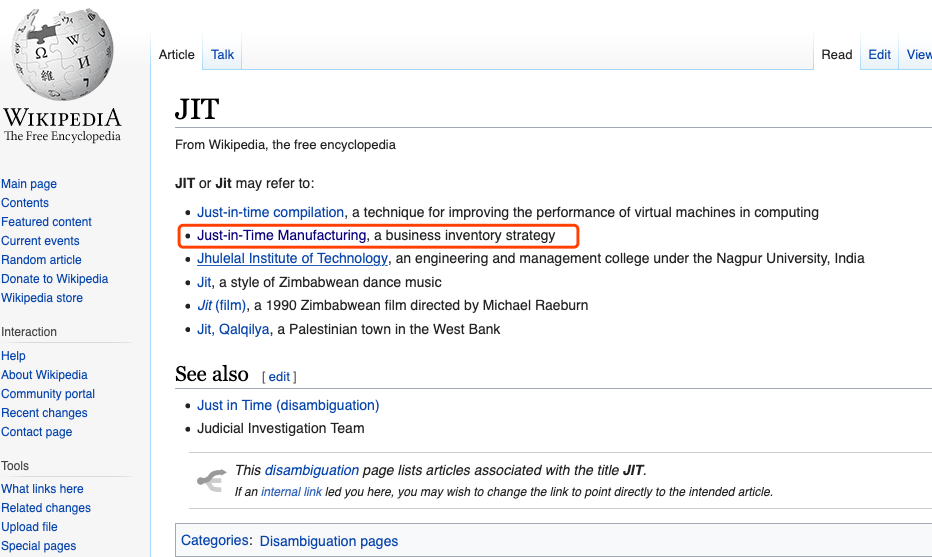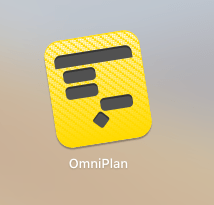JIT && TOC
最近受一位蓝朋友影响看了一些项管相关的书,这里做一下记录。记录的内容不多科普文。摘录内容源于wiki。
JIT TOC
了解下 JIT 当然这不是C#或者Java里的JIT .

JIT 内容相关
及时制度(JIT)
JIT的想法很简单:库存是资源浪费。JIT库存系统认为,库存带来了隐含的成本,因此高效率的企业应该不存在库存。公司需要采取一系列新的管理办法,进行变革。需要采取统计学、工业工程学、生产管理和行为科学中的管理办法。及时库存逻辑阐述了库存的内涵以及与管理的关系。库存会带来成本以及浪费,而不是增加或储存价值,这与传统会计学不同。这不是说,及时系统不需要对生产好的商品进行储存。而是鼓励企业逐步消除库存,以便削减生产流程中的成本。其次,在管理中逐渐适应“零库存”的状态。库存会带来很多附加成本,例如需要建立新的仓库、需要更新设备、减少流程的可变性、缺乏工人和设备灵活性、以及影响产量等。简单来说,及时制度主要的核心是“让正确的物资,在正确的时间,流动到正确的地方,数量是刚刚好的数量。”
环境影响
在及时制度的诞生初期,很多产品的日常运输还是用自行车,当生产规模加大时,就需要汽车和卡车. 庫蘇馬諾在1994提出了此系統在交通阻塞和石化燃料的使用下會產生及有可能產生的弊端. 而這些弊端這違反了及時制度制訂的三條減少浪費的原則:
時間 - 在交通阻塞中所浪費的時間
庫存 - 在交通阻塞中滯留的產品
廢棄物 - 在交通阻塞中, 無法移動的狀態下, 燃料仍持續的被消耗
影响价格
及时系统提出,库存让价格变化性大,因为库存让企业需要提前根据产量,采购原材料,原材料的价格又会有波动,因此提高了价格变化性。如果原材料价格提高,库存成本也提高。
质量波动
及时制度提出,进口零件的质量一般稳定,如果不稳定的话,企业就会增加成本。企业一般会与固定的供应商合作,降低原材料的质量波动和价格。
需求波动
卡马克 (1989) 提出,相对稳定的需求的重要性是,帮助保证效率、资本利用率。卡马克提出,如果需求不稳定,及时系统就会带来很高的资本成本。
供应稳定
美国1992年的铁路工人罢工引起了通用电气公司裁掉了7.5万名员工,因为公司的产品供应不出去。
JIT实施方法
- 设计产品流动流程
依生產流程重新設計/重新佈置場地與動線
减少每个批次的数量
合并可以合并的环节
平衡產线上下游的產能
預防保養
降低架設工時 - 全面质量控制
提高工人认知度
进行自动化检查
对质量进行量化测量
检测瑕疵产品
激发工人的参与 - 稳定生产时间
将生产时程平準化
建立冻结窗口(freeze windows)
保留部份產能 - 看板拉动系统
根据需求进行拉动管理
Backflush
减少每批次数量 - 与供應商合作
降低前置时间
頻繁但有規律的供貨
项目用法需求
统一质量 - 进一步降低其他部门的库存
降低零售店面库存
降低运输过程中库存
改善运输工具,减少运输库存
利用传送带,降低运输库存 - 改善产品設計
產品構型標準化
减少零件的数量
把产品设计进行流程化
统一质量
TOC 内容相关
限制理論(Theory of Constraints,TOC)是由以色列學者伊利雅胡·高德拉特所發展出來的一種全方面的管理哲學,主張一個複雜的系統隱含著簡單化。即使在任何時間,一個複雜的系統可能是由成千上萬人和一系列設備所組成。但是只有非常少的變數或許只有一個,稱為限制,它會限制(或阻礙)此系統達到更高的目標。
TOC的思考程序可協助答覆專注於改善時的主要問題:
什麼要改變?
要改變成什麼?
如何造成改變?
有時,另外兩個問題也會被列為思考程序:
為什麼要改變?
如何保持持續改善的過程(英语:Process of ongoing improvement-POOGI)?
TOC主張任何組織或企業成立之時必然有一目標,但同時也存在著許多限制阻礙組織或企業達成這個目標。因此為了達成其更高的績效,就必須打破這些限制,做到持續的改進。
中文wiki内容有限下面是英文内容:
The theory of constraints (TOC) is a management paradigm that views any manageable system as being limited in achieving more of its goals by a very small number of constraints. There is always at least one constraint, and TOC uses a focusing process to identify the constraint and restructure the rest of the organization around it. TOC adopts the common idiom “a chain is no stronger than its weakest link”. This means that processes, organizations, etc., are vulnerable because the weakest person or part can always damage or break them or at least adversely affect the outcome.
The five focusing steps
Theory of constraints is based on the premise that the rate of goal achievement by a goal-oriented system (i.e., the system’s throughput) is limited by at least one constraint.
The argument by reductio ad absurdum is as follows: If there was nothing preventing a system from achieving higher throughput (i.e., more goal units in a unit of time), its throughput would be infinite — which is impossible in a real-life system.
Only by increasing flow through the constraint can overall throughput be increased.[1]
Assuming the goal of a system has been articulated and its measurements defined, the steps are:
Identify the system’s constraint(s).
Decide how to exploit the system’s constraint(s).
Subordinate everything else to the above decision(s).
Alleviate the system’s constraint(s).
Warning! If in the previous steps a constraint has been broken, go back to step 1, but do not allow inertia to cause a system’s constraint.[4]
The goal of a commercial organization is: “Make more money now and in the future”,[5] and its measurements are given by throughput accounting as: throughput, inventory, and operating expenses.
The five focusing steps aim to ensure ongoing improvement efforts are centered on the organization’s constraint(s). In the TOC literature, this is referred to as the process of ongoing improvement (POOGI).
These focusing steps are the key steps to developing the specific applications mentioned below.
Constraints
A constraint is anything that prevents the system from achieving its goal. There are many ways that constraints can show up, but a core principle within TOC is that there are not tens or hundreds of constraints. There is at least one, but at most only a few in any given system. Constraints can be internal or external to the system. An internal constraint is in evidence when the market demands more from the system than it can deliver. If this is the case, then the focus of the organization should be on discovering that constraint and following the five focusing steps to open it up (and potentially remove it). An external constraint exists when the system can produce more than the market will bear. If this is the case, then the organization should focus on mechanisms to create more demand for its products or services.
Types of (internal) constraints
Equipment: The way equipment is currently used limits the ability of the system to produce more salable goods/services.
People: Lack of skilled people limits the system. Mental models held by people can cause behaviour that becomes a constraint.
Policy: A written or unwritten policy prevents the system from making more.
The concept of the constraint in Theory of Constraints is analogous to but differs from the constraint that shows up in mathematical optimization. In TOC, the constraint is used as a focusing mechanism for management of the system. In optimization, the constraint is written into the mathematical expressions to limit the scope of the solution (X can be no greater than 5).
Please note: organizations have many problems with equipment, people, policies, etc. (A breakdown is just that – a breakdown – and is not a constraint in the true sense of the TOC concept). The constraint is the limiting factor that is preventing the organization from getting more throughput (typically, revenue through sales) even when nothing goes wrong.
Breaking a constraint
If a constraint’s throughput capacity is elevated to the point where it is no longer the system’s limiting factor, this is said to “break” the constraint. The limiting factor is now some other part of the system, or may be external to the system (an external constraint). This is not to be confused with a breakdown.
Buffers
Buffers are used throughout the theory of constraints. They often result as part of the exploit and subordinate steps of the five focusing steps. Buffers are placed before the governing constraint, thus ensuring that the constraint is never starved. Buffers are also placed behind the constraint to prevent downstream failure from blocking the constraint’s output. Buffers used in this way protect the constraint from variations in the rest of the system and should allow for normal variation of processing time and the occasional upset (Murphy) before and behind the constraint.
Buffers can be a bank of physical objects before a work center, waiting to be processed by that work center. Buffers ultimately buy you time, as in the time before work reaches the constraint and are often verbalized as time buffers. There should always be enough (but not excessive) work in the time queue before the constraint and adequate offloading space behind the constraint.
Buffers are not the small queue of work that sits before every work center in a Kanban system although it is similar if you regard the assembly line as the governing constraint. A prerequisite in the theory is that with one constraint in the system, all other parts of the system must have sufficient capacity to keep up with the work at the constraint and to catch up if time was lost. In a balanced line, as espoused by Kanban, when one work center goes down for a period longer than the buffer allows, then the entire system must wait until that work center is restored. In a TOC system, the only situation where work is in danger is if the constraint is unable to process (either due to malfunction, sickness or a “hole” in the buffer – if something goes wrong that the time buffer can not protect).
Buffer management, therefore, represents a crucial attribute of the theory of constraints. There are many ways to apply buffers, but the most often used is a visual system of designating the buffer in three colors: green (okay), yellow (caution) and red (action required). Creating this kind of visibility enables the system as a whole to align and thus subordinate to the need of the constraint in a holistic manner. This can also be done daily in a central operations room that is accessible to everybody.
Plant types
There are four primary types of plants in the TOC lexicon. Draw the flow of material from the bottom of a page to the top, and you get the four types. They specify the general flow of materials through a system, and also provide some hints about where to look for typical problems. This type of analysis is known as VATI analysis[6] as it uses the bottom-up shapes of the letters V, A, T, and I to describe the types of plants. The four types can be combined in many ways in larger facilities, e.g. “an A plant feeding a V plant”.
V-plant: The general flow of material is one-to-many, such as a plant that takes one raw material and can make many final products. Classic examples are meat rendering plants or a steel manufacturer. The primary problem in V-plants is “robbing,” where one operation (A) immediately after a diverging point “steals” materials meant for the other operation (B). Once the material has been processed by A, it cannot come back and be run through B without significant rework.
A-plant: The general flow of material is many-to-one, such as in a plant where many sub-assemblies converge for a final assembly. The primary problem in A-plants is in synchronizing the converging lines so that each supplies the final assembly point at the right time.
T-plant: The general flow is that of an I-plant (or has multiple lines), which then splits into many assemblies (many-to-many). Most manufactured parts are used in multiple assemblies and nearly all assemblies use multiple parts. Customized devices, such as computers, are good examples. T-plants suffer from both synchronization problems of A-plants (parts aren’t all available for an assembly) and the robbing problems of V-plants (one assembly steals parts that could have been used in another).
I-plant: Material flows in a sequence, such as in an assembly line. The primary work is done in a straight sequence of events (one-to-one). The constraint is the slowest operation.
From the above list, one can deduce that for non-material systems one could draw the flow of work or the flow of processes, instead of physical flows, and arrive at similar basic V, A, T, or I structures. A project, for example, is an A-shaped sequence of work, culminating in a delivered product (i.e., the intended outcome of the project).
甘特图
甘特图我推荐用下面这个,平时我做计划几乎都离不开Omniplan,它支持导出Project格式,同时支持任务排期跳过节假日等。

本文标题:JIT && TOC
文章作者:Keyle
发布时间:2019-04-30
最后更新:2024-08-20
原始链接:https://vrast.cn/posts/cd9ab0aa/
版权声明:©Keyle's Blog. 本站采用署名-非商业性使用-相同方式共享 4.0 国际进行许可